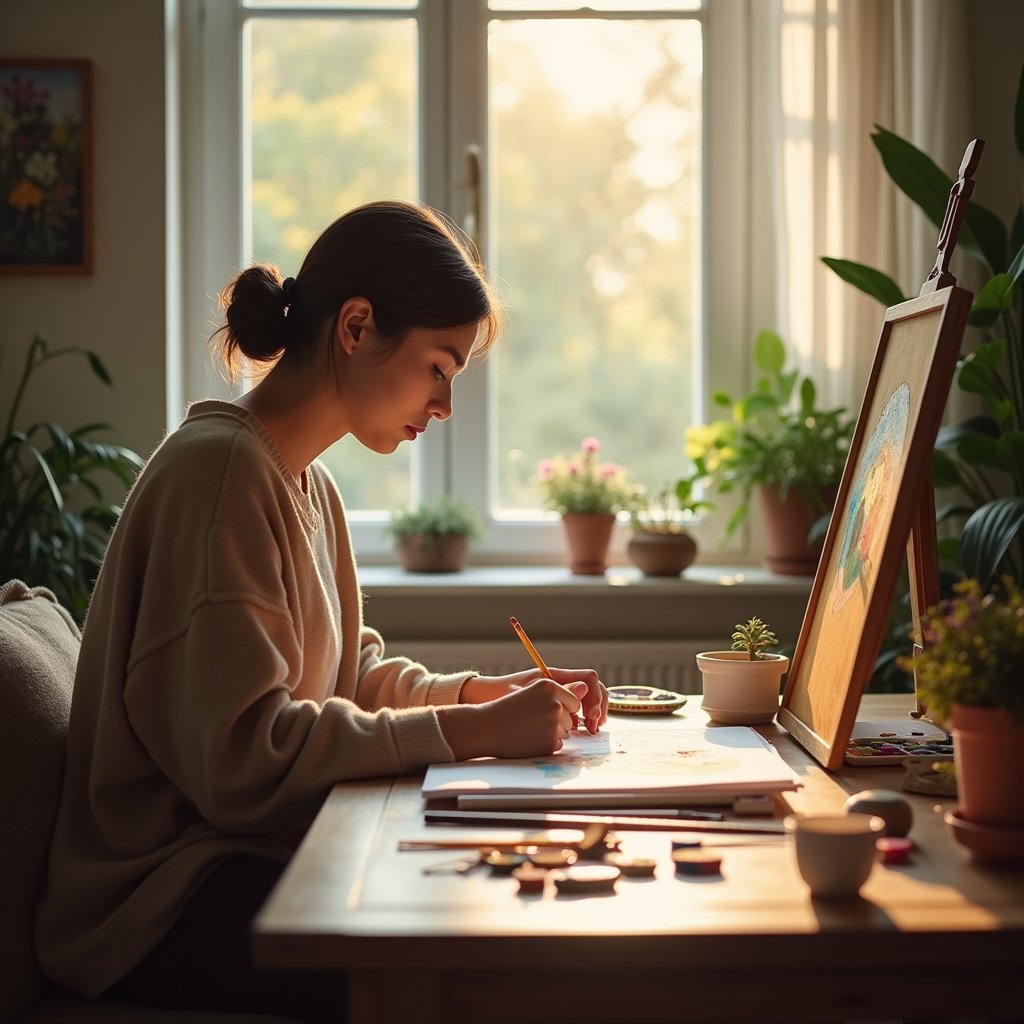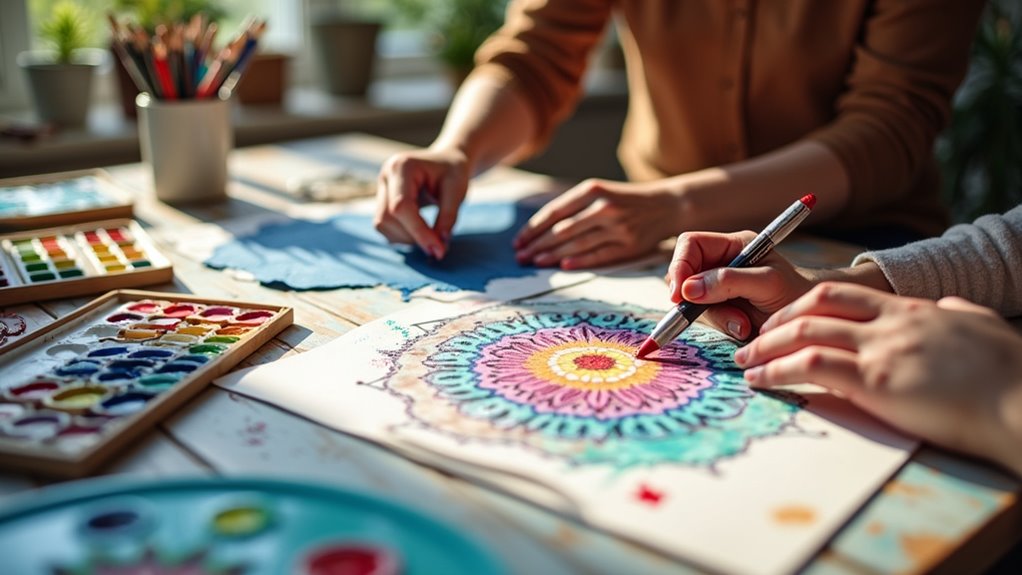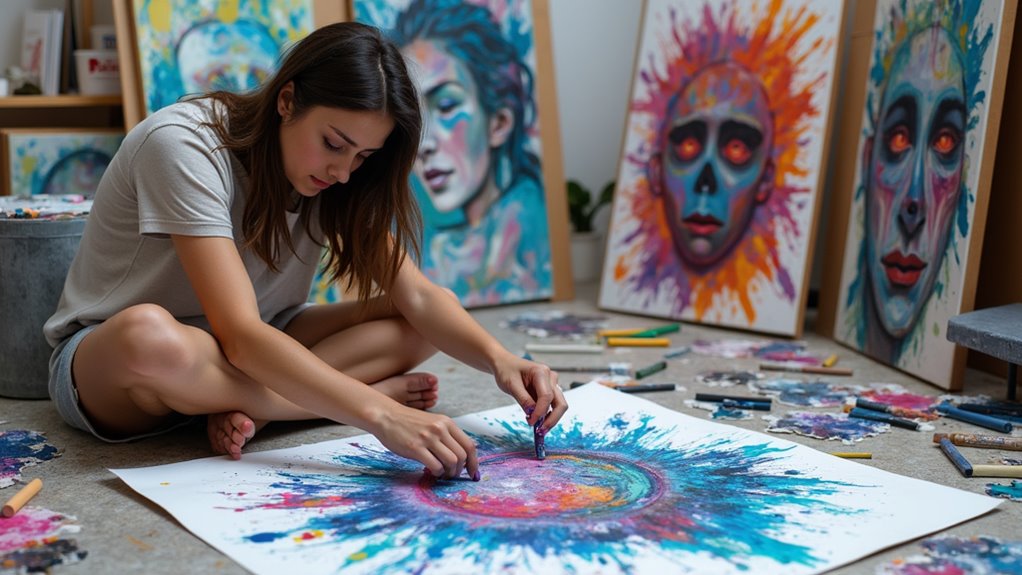Art therapy works by engaging your brain’s natural healing abilities through creative expression. When you create art, your brain releases mood-boosting chemicals like dopamine and serotonin while activating areas that regulate emotions. You don’t need artistic skill the focus is on the process of expressing feelings through drawing, sculpting, or other visual methods. Clinical studies show it effectively reduces symptoms of anxiety, depression, PTSD, and other mental health conditions. Understanding the science behind art therapy reveals even more powerful benefits for your wellbeing.
The Science Behind Art Therapy’s Mental Health Benefits

While many people understand art therapy as a creative outlet, the neuroscience behind its effectiveness reveals a complex interplay of brain chemistry and neural processes.
When you engage in art therapy, your brain experiences measurable neurochemical effects, including increased dopamine and serotonin production, which naturally elevate mood and reduce stress.
Brain activity patterns show improved activation in the prefrontal cortex and modulated amygdala response, directly impacting emotional regulation and stress management. Art therapy requires no artistic skill to be effective as a therapeutic treatment.
The process strengthens cognitive resilience by forming new neural pathways and improving problem-solving capabilities.
Clinical efficacy studies demonstrate that these biological changes translate into tangible mental health improvements, with participants showing reduced anxiety, decreased depression symptoms, and better emotional processing abilities.
The science confirms that art therapy’s benefits extend far beyond simple self-expression, as studies show lower blood pressure and other physiological improvements during creative engagement.
The science confirms that art therapy’s benefits extend far beyond simple self-expression.
Core Techniques and Creative Approaches in Art Therapy

Art therapists employ a varied toolkit of creative techniques to address multiple mental health challenges. Through collage exploration, embodied practices, and integrative methods, you’ll uncover powerful ways to process emotions and trauma. These evidence-based approaches combine traditional art-making with modern therapeutic techniques to support your healing expedition. Psychoanalytic principles guide therapists in helping clients explore unconscious thoughts through their artwork.
– Visual methods like drawing and sculpting help you express complex feelings without needing artistic skill, making therapy accessible regardless of your creative background.
Safe, non-judgmental environments enable participants to freely explore their emotions without fear of criticism or evaluation.
- Movement-based techniques integrate physical expression with art-making, allowing you to release stored emotions through dance and embodied practices.
- Collaborative approaches, including group projects and shared murals, foster connection and support while building social skills through creative expression.
The combination of these techniques provides an extensive framework for addressing a range of mental health concerns through artistic engagement.
Mental Health Conditions Treated Through Art Therapy

Research demonstrates that art therapy effectively treats a broad spectrum of mental health conditions, from mood disorders to cognitive impairments.
If you’re struggling with depression or anxiety, art therapy applications can help reduce symptoms through creative expression while building coping skills and self-esteem. Through self-expression activities, individuals can explore their emotions without the pressure of verbal communication. Working with trained art therapists helps ensure interventions are properly tailored to your specific needs.
For those dealing with PTSD, you’ll uncover relief through externalizing traumatic experiences in a safe, non-verbal way.
Art therapy’s benefits extend to cognitive conditions like dementia, where it helps maintain mental function and quality of life.
If you’re managing schizophrenia or autism, you’ll find that artistic expression strengthens social skills and emotional regulation.
The therapy’s versatility makes it particularly valuable for developmental disorders, offering ways to improve sensory processing and communication beyond verbal limitations.
The Therapeutic Process: From Canvas to Healing
When you step into an art therapy session, you’ll reveal a structured yet deeply personal voyage of healing through creative expression. Your therapist will guide you through selecting artistic mediums that resonate with your comfort level, whether that’s painting, sculpting, or collage-making. Art therapy originated in 1940s, showing its long-standing role in mental healthcare.
Art therapy has proven particularly beneficial for patients with PTSD, offering a safe pathway to process traumatic experiences. You don’t need artistic skill – the focus is on emotional exploration, not technical mastery.
Through this therapeutic process, you’ll uncover how to:
- Transform difficult emotions into visual symbols, making them easier to process and understand
- Release inner tension through tactile engagement with art materials
- Access and express feelings that might be challenging to put into words
Your expedition involves collaborative goal-setting, guided artistic expression, and meaningful discussions about your creations, helping you build self-awareness and emotional resilience along the way.
Research-Backed Results and Clinical Outcomes
Clinical studies consistently demonstrate the measurable impact of art therapy across diverse mental health conditions. When you look at the research data, you’ll find compelling evidence for art therapy’s effectiveness, with documented improvements in multiple areas:
| Condition | Clinical Outcomes |
|---|---|
| Schizophrenia | Reduced positive/negative symptoms |
| Anxiety/Depression | 73% reduction in ASD patients |
| PTSD | 50-76% symptom improvement in veterans |
| Chronic Pain | 71% reported significant relief |
The evidence supports art therapy’s role in improving emotional awareness, reducing psychological distress, and enhancing overall mental health. Research shows that engaging in artistic activities induces a natural flow state that helps patients maintain present-moment awareness. For instance, 85% of pregnant women report reduced anxiety through art therapy interventions, while 79% of participants show improved self-esteem. These clinical outcomes demonstrate that art therapy isn’t just an alternative treatment – it’s a scientifically-validated therapeutic approach delivering measurable results. With over 650 million people worldwide having benefited from art therapy, the scope and reach of this therapeutic approach continues to expand globally.
Frequently Asked Questions
How Much Does Art Therapy Typically Cost per Session?
You’ll find art therapy pricing typically ranges from $100-150 per session, with standard 45-minute sessions at the lower end and 90-minute sessions at the higher end.
Session affordability can improve through different options – you’re eligible for 25% discounts if you’re a teacher, military member, or healthcare worker.
Some programs offer income-based reductions, and you might access financial aid or scholarships to help manage costs.
Initial assessments are $200.
Can I Practice Art Therapy at Home Without a Licensed Therapist?
Yes, you can practice self-guided art therapy techniques at home through creative expression activities like drawing, painting, or collage-making.
While it won’t replace professional therapy, you can still benefit from art’s therapeutic qualities by setting aside dedicated time, using basic supplies, and following online prompts or guided exercises.
Just remember to maintain realistic expectations and consider it a complementary tool for emotional well-being rather than a substitute for professional help when needed.
What Qualifications Should I Look for When Choosing an Art Therapist?
When choosing an art therapist, you’ll want to verify they’ve proper certification requirements, including a master’s degree and ATR credential from the Art Therapy Credentials Board.
Look for therapist experience working with your specific concerns, whether that’s trauma, anxiety, or other challenges.
Don’t hesitate to ask about their specialized training, years of practice, and approach to treatment.
You can verify their credentials through the ATCB’s official registry.
Are Art Therapy Sessions Covered by Health Insurance Plans?
Your insurance coverage for art therapy varies by plan and location.
Under the Affordable Care Act, many insurers offer therapy benefits when it’s deemed medically necessary.
You’ll need to verify that your therapist has both a mental health license (like LPC or LMFT) and art therapy certification (ATR-BC) for coverage.
Contact your insurance provider to check specific requirements, copays, and whether you’ll need a doctor’s referral to access these services.
How Long Does It Usually Take to See Results From Art Therapy?
You’ll typically notice an art therapy timeline varies based on your specific needs.
Initial stress relief can emerge after just one 45-minute session, while deeper trauma-focused outcomes usually take 8-15 weeks to show significant improvement.
Therapy effectiveness is highest when you maintain consistent practice and integrate it into your daily routine.
For conditions like PTSD or chronic pain, you might see substantial results (50-71% symptom reduction) within a few months of regular sessions.

